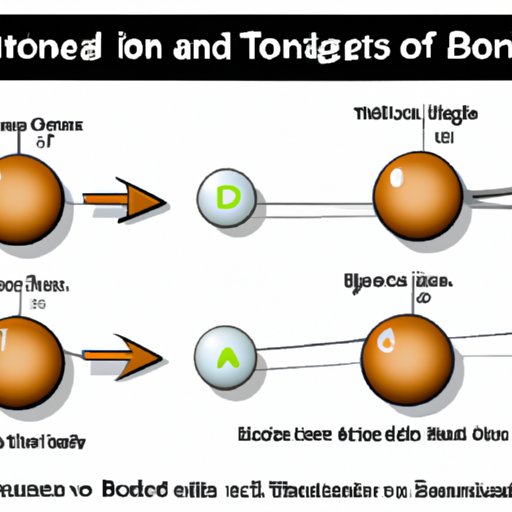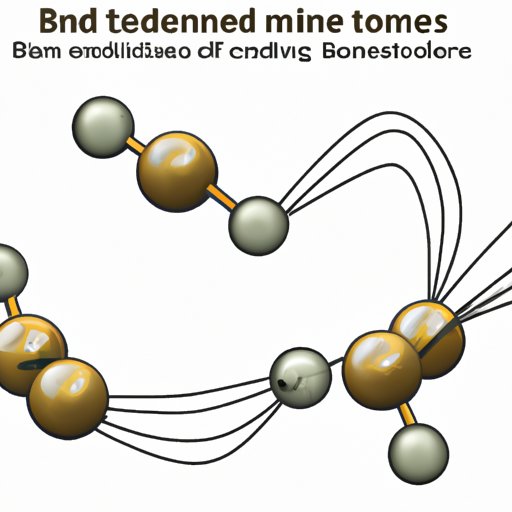Introduction
Understanding the differences between metallic bonds and ionic bonds is a crucial part of chemistry education, as it is an essential step towards grasping more complex chemical reactions. Metallic and ionic bonds are both fundamental types of bonding that occur in different materials. However, there is one key factor that sets them apart from each other. In this article, we will explore this factor in detail and explain how it determines the properties of each type of bond.

Breaking Down the Differences: The Key Factor That Separates Metallic Bonds from Ionic Bonds
Metallic bonds refer to the electrostatic attraction between a sea of electrons and positively charged ions that hold metallic atoms together. On the other hand, ionic bonds occur due to the electrostatic attraction between cations and anions. The key factor that distinguishes metallic bonds from ionic bonds is the nature of the bond formed between the atoms of a given material. Metallic bonds are formed out of delocalized electrons, while ionic bonds are formed due to transfer of electrons from one atom to the other.
As an example, let’s consider the differences between sodium chloride (NaCl), which is an example of an ionic compound, and copper, which is a metal. The sodium and the chlorine atoms of NaCl form an ionic bond as a result of the transfer of their respective electrons to form Na+ and Cl- ions. In contrast, metallic bonding in copper occurs between the positively charged copper ions and the ‘sea of electrons,’ which is made up of delocalized valence electrons that move freely through the structure.
The Chemistry Behind Metallic Bonds vs Ionic Bonds: Understanding the Key Differentiating Factor
The differences between metallic and ionic bonds involve the way they are formed and their underlying chemistries. Metallic bonding is a type of chemical bonding that results from the sharing of a “sea” of delocalized electrons formed by metallic atoms interacting with each other. The delocalized electrons create an electron cloud that can ‘move’ throughout the compound.
Ionic bonding differs from metallic bonding in that the electrons involved aren’t shared between atoms. Instead, an atom donates an electron to another atom and creates an ion. The resulting cation or anion, which is positively or negatively charged, binds together and forms an ionic bond.
What Makes Metallic Bonds Unique? Examining the Critical Distinctions from Ionic Bonds
Metallic bonds have a number of unique properties that distinguish them from ionic bonds. Firstly, they are malleable and ductile, indicating that they can be hammered into sheets or stretched into wires without breaking. This is because the ‘sea of electrons’ is free to move and can adjust to the new shape of the object without breaking the bonds holding the individual atoms together.
Secondly, metallic bonds are excellent conductors of heat and electricity. This is due to the fact that the ‘sea of electrons’ can easily carry energy or electric current thanks to their high mobility through the compound.
Unpacking the Key Distinction: The Factor That Sets Metallic Bonds Apart from Ionic Bonds
The key factor that sets metallic bonds apart from ionic bonds is the nature of the bond formed between the atoms of a given material. Metallic bonds occur due to the sharing of delocalized electrons between atoms, while ionic bonds involve the transfer of electrons from one atom to another.
This distinction has a number of important implications. First, it explains why metallic bonds are more malleable and ductile than ionic bonds. As the ‘sea of electrons’ is free to move from atom to atom, it can adjust itself so that the material can be shaped without disrupting the bond between metallic atoms. In contrast, ionic bonds are much more rigid, as their structure is held together by the electrostatic forces between oppositely charged ions, rather than the more flexible nature of the ‘sea of electrons’ in metallic bonds.
Navigating the Differences: The Essential Factor that Distinguishes Metallic Bonds from Ionic Bonds
It is essential to understand the differences between metallic bonds and ionic bonds to help identify which type of bond is present in a given material or chemical compound. You can identify which type of bond occurs by examining the composition of the substance in question.
For instance, elements that form metallic bonds are generally located to the left and in the middle of the periodic table of elements. In contrast, those that form ionic bonds are non-metallic elements located to the right of the periodic table.
The Science Behind Metallic Bonds and Ionic Bonds: Examining the Crucial Difference
Overall, the key factor that distinguishes metallic bonds from ionic bonds is the nature of the bond between atoms. Metallic bonds involve sharing of delocalised electrons, while ionic bonds are formed due to transfer of electrons from one atom to the other.
The chemical nature of each bond leads to fundamental differences between them that can be observed in their properties. For example, metallic bonds have high malleability and ductility, excellent conductivity of heat and electricity, and high melting points. Meanwhile, ionic bonds are usually brittle, can be good insulators, and have high melting points and boiling points.
Metallic Bonds vs Ionic Bonds: The One Factor That Determines Their Properties
Understanding the differences between metallic bonds and ionic bonds is essential in furthering your understanding of chemistry, materials science, and other related disciplines. The key factor that determines their individual properties is the nature of the bond formed between the atoms of a given material.
The malleability, ductility, and conductivity of metallic bonds, and the high melting and boiling points of ionic bonds all relate back to the differing nature of these chemical bonds. By understanding this crucial distinction, you can better comprehend the properties of different substances and even predict their chemical reactivity.
References
- Chegg Study. (n.d.). Metallic Bonding. Chegg.com. https://www.chegg.com/homework-help/definitions/metallic-bonding-14
- Ophardt, C. E. (2003). Ionic vs. Covalent vs. Metallic Bonding. Elmhurst College. https://www.elmhurst.edu/~chm/vchembook/141Aioniccomp.html
- Rose-Hulman Institute of Technology. (n.d.). Metallic Bonds. Rose-Hulman.edu. https://www.rose-hulman.edu/class/chemistry/faculty/young/c101/MetallicBonds.
